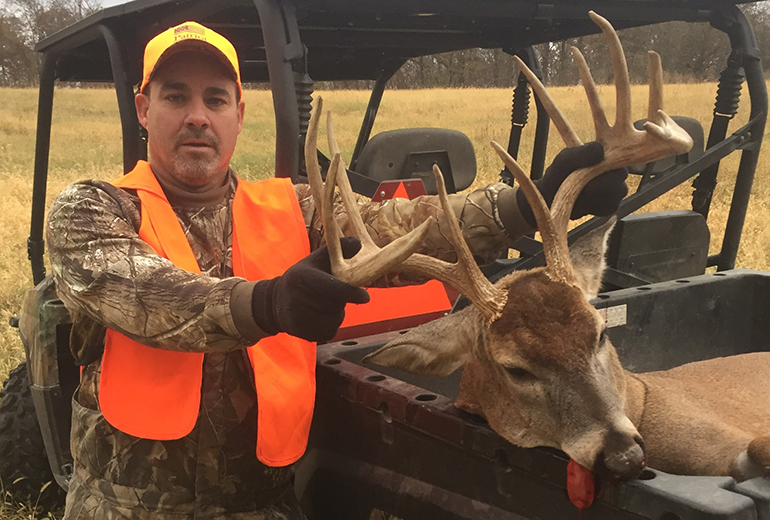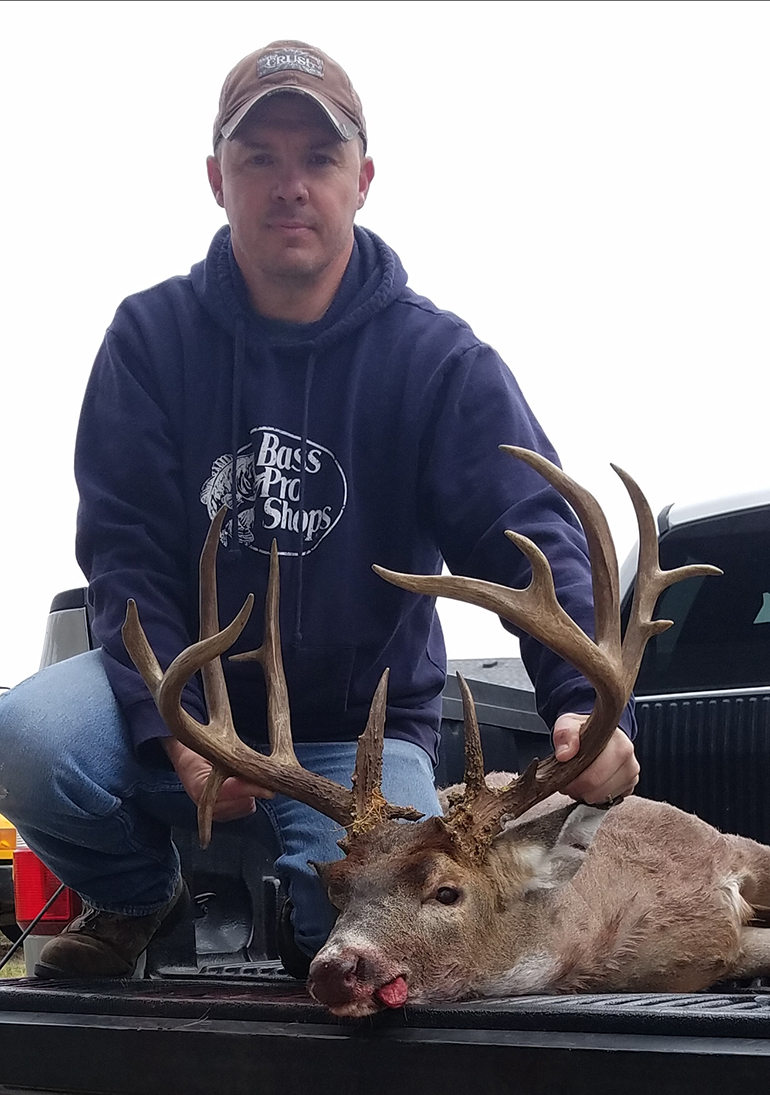
Missouri is known as a trophy whitetail State and for good reason. The Show-Me State holds some of the top places in the deer hunting record books.
The world record non-typical buck known as the Missouri Monarch is the No. 1 all-time best non-typical whitetail buck that netted 333 7/8 inches. It was found dead by a firearms deer hunter in November 1981 in St. Louis County. The third all-time best typical whitetail buck in the B&C record book was taken by Larry W. Gibson in Randolph County in 1971. It netted an impressive 205 inches.
To qualify for the “all-time” Boone & Crockett Club’s record book, a whitetail buck must score 170 inches as a typical or 195 inches as a non-typical. If they can’t meet the all-time standard, they can still make the B&C Big Game Awards Book with a minimum score of 160 inches typical and 185 inches non-typical.
All three of the bucks featured in this article have the potential to make it into one of the Boone and Crockett Club’s record books and are trophies in the eyes of hunters across the state.

TOM BRITTAIN’S KNOX COUNTY KNOCKOUT
Fifty-year-old Tom Brittain of Foristell, Mo., has been deer hunting since he was 10 years old. He got his first deer, a spike buck, at age 13 while hunting with his dad on public ground near Mark Twain Lake.
“Deer hunting has always been my hobby since I was a kid,” Brittain said. “It’s what I do when I’m not working.”
Brittain’s job in the power industry keeps him working hard and out of town a lot, but he still manages to put in 25 days of hard deer hunting a year at the 800-acre lease he hunts on in Knox County.
The 2017 season was the third year Brittain has been hunting this particular lease, and he has a good idea what the deer do on this property, which is made up of about 300 acres of timber with some hayfields and most of the remainder in crops. In 2016, he killed a 150-class 12-pointer off the property and had high hopes for another trophy.
Brittain had been hunting from a box blind that was 12 feet off the ground on a big hayfield. On each side, there were crops with some thick timber behind him.
On the fourth day of the firearms season, Brittain got into his tower blind at about 5:30 a.m. He spooked four deer while walking into his stand. As soon as it was light enough to see, Brittain saw some small bucks chasing does in a nearby draw. He kept his focus on that area until around 7 a.m. when a doe came out into the hayfield about 400 yards away. She casually grazed in the field, then movement in a draw off the field caught Brittain’s eye. It was two big bucks!
Brittain’s heart rate escalated as the doe began moving in his direction with the bucks in tow behind her. Some 20 minutes later, the three deer moved within 100 yards of Brittain’s stand, and that was close enough for him. The hunter eased up his rifle and put the crosshairs of the Tasco scope on the big 12-pointer and squeezed the trigger. The trophy buck collapsed in his tracks with the report of the Remington .30-06.
“The buck was even bigger than I thought,” Brittain said. “The mass on this buck is incredible.”
Brittain’s buck green scores 174 inches typical with a 19-inch inside spread and 5 inches of mass on the main beams!

BRYAN LOYD’S VOLUMINOUS VERNON COUNTY BUCK
Bryan Loyd of Nevada, Mo., has been deer hunting since he was just 7 years old. His father David Loyd taught him the basics of deer hunting on the family farm. Deer hunting created an inseparable bond between Bryan and his father.
“Dad taught me everything I know,” Loyd said. “He was always there for me, and we always manage to get at least a few days away from work to deer hunt together each year.”
That hunting knowledge that the elder Loyd passed on to his son paid off with big buck dividends for Bryan over the years.
Bryan Loyd’s trophy hunting attitude began when he was 16 years old when he shot a 190-class buck. That mentality led to a 200-class buck he bagged in 2003, a 170-class buck in 2013 and the trophy he bagged on the last day of the 2017 firearms deer season last year.
“I didn’t get to do much deer hunting like normal last year because of work and with my dad being sick with cancer,” Loyd said. “But I managed to get out as much as I could.”
Loyd was hunting on the 380-acre family farm in Vernon County. The habitat there is thick and comprised of reclaimed strip pits from coal mining in the 1950s. The family has been hunting this tract of land since around 1989, and they have a good knowledge of where the deer travel through the brushy terrain.
According to Bryan Loyd, hunting had been very tough when he had the chance to go last year. All he was seeing were does and a few small bucks. And with his trophy mentality, he was holding out for something big or nothing at all.
Loyd likes to still hunt most of the time, and he started the final day of Missouri’s firearms season slowly making his way across the middle of the 380 acres. When he made it to a spot where they had a shooting bucket to sit on in the middle of the property, he decided to sit awhile.
The weather was in the mid 50s and partly cloudy that morning with a southeast wind that was blowing just right for where Loyd was hunting. At about 9:20 a.m., Loyd spotted two does about 70 yards out. The second doe kept looking behind her, which alerted the savvy hunter that a buck might not be far behind.
About 10 minutes later, he spotted a buck with a good set of antlers on its head. He couldn’t tell exactly how big the buck was, but because it was the last day of the season, it was good enough. The buck stopped on its own in a small opening, giving Loyd time to get the crosshairs of his Bushnell scope on the buck’s vitals. And when he squeezed the trigger of the Ruger .300 Win. Mag., the buck dropped where it once stood.
Bryan Loyd scored the enormous-bodied buck at around 170 inches. It featured 5-inch bases, good mass throughout the main beams and 11-inch G2s.
“I got really lucky on the last day of the season,” Loyd said. “I wasn’t seeing any good deer on the days I got to hunt, and I am fortunate to take such a good buck and my dad getting to see it, even though he couldn’t go hunting with me that day because he was so sick.”
Bryan Loyd’s voluminous Vernon County buck field dressed at over 200 pounds. Unfortunately, Bryan’s dad passed away in December.
“It was a bittersweet season,” concluded Loyd.

BRIAN VINSON’S DOUGLAS COUNTY TROPHY
Brian Vinson of Ava, Mo., is a 46-year-old deer hunter who has been chasing bucks since he was just 10 years old. His father was more of a turkey hunter than a deer hunter, so Brian had to learn a lot about whitetails on his own.
Vinson killed his first really big buck, a 150-class 10-pointer back in 1992, and he vowed he would never get another buck mounted until he got one bigger than that. It took 25 seasons for him to surpass that 10-pointer, but he did it during the 2017 firearms deer season in Missouri.
“I hunted very hard every day of the firearms deer season,” Vinson said. “I saw deer every day, but most of them were does or small bucks; but, I did see a good 10-pointer that saw me before I saw him.”
Vinson hunts on his father-in-law’s property, which is a tract of about 400 acres in Douglas County. The land includes some fescue in the bottom fields, cedar glades and mostly steep rolling hills of timber. But the neighbor has some good clover fields that adjoin the land he hunts.
Vinson had been hunting one big buck in particular but could never see him during daylight hours. For three years, the veteran hunter tried to catch the buck while the sun was up but never could during firearms deer season.
“This buck was a night-timer; we could only get pics of this deer on trail camera at night,” Vinson said. “The day before gun season in 2016, I did see the buck out in an open field chasing a doe but couldn’t do a thing about it.”
Once again Vinson was after the big buck, and on the fifth day of the season, he walked up on top of a ridge and found a scrape line that had some really huge ground scrapes, and he figured it was from the buck he’d been pursuing.
The next day around 2 o’clock, Vinson made his way back up the ridge to see if the scrapes had been worked, and they had been! Cedar trees 12 inches in diameter were also shredded on the ridge.
Vinson knew a big buck was in the area, so he picked a rock to sit on and waited. He hadn’t been seated for more than five minutes when he looked up and saw two huge bucks standing in the brush just 25 yards away!
“One of the bucks was the one I’ve been hunting for the past couple years, and the other was a really big 10-pointer,” said Vinson. “They were just standing there, and I think they must have been fighting and were oblivious to me.”
Vinson had his .223 on his lap and in one motion picked it up, took off the safety and fired at the bigger of the two deer. The first shot seemingly missed, but the buck just stood there as the 10-pointer ran away. The giant deer then began walking away. At a distance of 30 yards, Vinson managed to get off a second round as the deer was quartering away, and the buck bolted for 20 yards and then collapsed.
Upon later inspection of the buck, Vinson found out his first shot grazed the buck’s antler and stunned him, giving Vinson time for the second shot! All of this excitement happened in less than a minute.
Vinson’s Douglas County trophy features 18 points and officially nets 181 5/8 inches as a non-typical!
ON-X: AN EXTRAORDINARY APP FOR HUNTERS
You’ve heard that “x” marks the spot. Well onX Hunt, an app designed for hunters, puts new meaning into that old adage.
As an avid deer and turkey hunter in Missouri, I’ve found the onX app to be easy to use and pretty much incredible. In no time, I was able to zero in on our favorite hunting land in eastern Missouri and was quickly impressed with the way I could switch maps from satellite imagery to topo maps or even a hybrid of both.
If that doesn’t tickle your fancy, consider that this GPS mapping app allows for putting in custom waypoints and GPS tracking. And two of the most impressive capabilities of this app are that it not only shows public land boundaries, but it also shows private land boundaries complete with the property owner’s name. Additionally, those concerned with losing signal can save layers of the map to access while out of range.











































